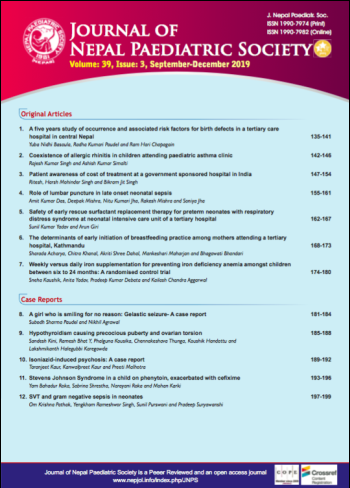SVT and Gram Negative Sepsis in Neonates
DOI:
https://doi.org/10.3126/jnps.v39i3.28641Keywords:
gram negative sepsis, neonatal sepsis, supraventricular tachycardiaAbstract
Supraventricular tachycardia is the most common tachyarrhythmia seen in fetuses, neonates and infants. Sustained SVT may lead to congestive cardiac failure. Neonatal supraventricular tachycardia is more commonly associated with other cardiorespiratory and congenital problems and is uncommon in an otherwise healthy infant. Supraventricular tachycardia is also caused by neonatal sepsis but has rarely been reported. Here, we report two cases of SVT (Supraventricular tachycardia) induced by neonatal sepsis. Two neonates, one male and another female, both born to Indian mother had tachycardia with heart rate > 220 beats/minute along with poor perfusion, tachypnoea, fever and deranged coagulation profile. Both the babies had culture positive gram negative sepsis with normal echocardiography and supraventricular tachycardia on electrocardiograms which were treated with anti arrhythmic drugs and treatment of sepsis. This case report gives further insight into one more presentation and complication of neonatal sepsis.
Downloads
Downloads
Published
How to Cite
Issue
Section
License
Authors who publish with this journal agree to the following terms:
Authors retain copyright and grant the journal right of first publication with the work simultaneously licensed under a Creative Commons Attribution License that allows others to share the work with an acknowledgement of the work's authorship and initial publication in this journal.
Authors are able to enter into separate, additional contractual arrangements for the non-exclusive distribution of the journal's published version of the work (e.g., post it to an institutional repository or publish it in a book), with an acknowledgement of its initial publication in this journal.
Authors are permitted and encouraged to post their work online (e.g., in institutional repositories or on their website) prior to and during the submission process, as it can lead to productive exchanges, as well as earlier and greater citation of published work (See The Effect of Open Access).



